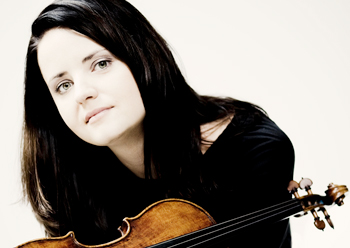by Daniel Hathaway

Ironically, the evening began and ended with dawn, first in the form of Mussorgsky’s Prelude that captures sunrise on the Moscow River. Only about five minutes long, it begins and ends quietly, arcing to a climax in the middle amid lovely birdsong from the winds and church bells in the percussion.
Shostakovich wrote his Second Violin Concerto in 1967 as a 60th birthday present for David Oistrakh, but got the date wrong and finished it a year early. The fine Latvian violinist Baiba Skride spent the first two movements of the work weaving her solo lines in and out of Shostakovich’s somber, meandering orchestral textures, interrupted from time to time by outbursts on a side drum and later, razzes from the brass. Dialogues with solo horn, flute, and bassoon occasionally relieved the gloom, and a persistent three-beat rhythmic figure like an ominous knock on the door got passed back and forth between soloist and orchestra.
After an attempt or two to break out of this emotional tedium, in the final movement Shostakovich introduces a mawkish rondo with ever-changing meter. That finally gave Skride her opportunity to play with breathtaking virtuosity, especially in the dramatic cadenza, where the soloist herself interrupts the piece before it resumes its wild progress.
Guest conductor Alain Altinoglu shaped a compelling, well-balanced performance that allowed Skride room to be heard even through thick orchestral textures. One hushed string passage in the second movement was magical. The audience responded with a warm, extended ovation.

The work is integrated, mostly on a subliminal level, by a theme that changes or is transformed in the course of five movements. Each is dominated in turn by the woodwinds, strings, brass, and percussion, and each is based on a single concept. Incantation, Line, Obsession, and Torpid are followed by the fifth movement, appropriately titled Flamboyant, which fuses all the the orchestral voices in a complex web. Altinoglu and the Orchestra gave Métaboles a mesmerizing reading, and principal trumpet Michael Sachs was rewarded with a special bow.
The second sunrise of the evening, Ravel’s Daybreak (“Lever du jour”), raises the curtain on a lush pastoral scene in classical antiquity to open the second Daphnis and Chloé suite. After a powerful crescendo into dawn, the scenario changes to a romantic Pantomime between a mythical shepherd and shepherdess, and ends with a raucous Danse générale in 5 beats to the bar — certainly a challenge for Diaghilev’s Ballets Russes dancers in 1912.
Piccoloist Mary Kay Fink, E-flat clarinetist Daniel McKelway, oboist Jeffrey Rathbun, and flutist Joshua Smith and his section colleagues brought shepherds and panpipes to life. Seven percussionists and timpani — plus keyboardist Joela Jones, who joined them on bells at the height of the festivities — enhanced the spectacular conclusion. Altinoglu led the suite with energy and surgical precision, and The Cleveland Orchestra infused the piece with dazzling color. The audience response was rapturous.
Published on ClevelandClassical.com October 17, 2016.
Click here for a printable copy of this article

